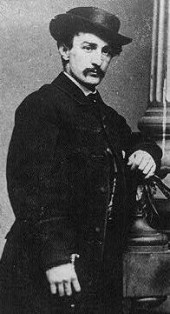As he lay hiding in the pine thicket along the Potomac River, seven days after assassinating President Lincoln, John Wilkes Booth began to think his act had been in vain. “I am here in despair,” he wrote. “And why? For doing what Brutus was honored for-what made Tell a hero. My action was purer than theirs…I have too great a soul to die like a criminal. O, may He spare me that, and let me die bravely.!” Booth, a strikingly handsome, successful actor and strong supporter of the Confederacy, had planned for months to abduct Lincoln to force the release of Southern prisoners. But after Lee surrendered on April 9, 1865, Booth’s plots were rendered useless. He spent the next few days glumly drinking muck brandy at John Deery’s billiard hall in Washington, D.C.. When he shot the President on April 14 the act apparently was unplanned until that day, when Booth happened to hear that Lincoln was to see Our American Cousin at Ford’s Theatre that night. It was during the second scene of the third act, after 10 p.m., that the 26-year-old Booth entered Lincoln’s box and shot him in the back of the head. He stabbed an officer who tried to grab him, then leaped to the stage 12 feet below, yelling, “Sic semper tyrannis! The South is avenged!” As he jumped his boot spur got caught in the folds of an American flag draped along the President’s box, causing him to fall and break his left leg as he hit the stage, where he stabbed the orchestra conductor, who tried to stop him, then struggled down the rear stairs to an awaiting horse that was being held by a stagehand. As Booth fled the city-his fractured leg tearing deeper and deeper into his flesh-he was joined by 19-year-old David Herold, who as one of eight in Booth’s gang had shot and wounded Secretary of State William Seward. Two men who were to kill Vice President Andrew Johnson backed out. Booth and Herold rode through the night southward in to Maryland. They turned eight miles out of their way to arrive at the home of Dr. Samuel Mudd, who set Booth’s leg at 4:30 a.m.. From there the two men rode on to the Potomac, where they hid along the banks for a week, surrounded by Army troops but supplied food and newspapers by a Confederate sympathizer. The troops finally caught up with the two men in the early morning hours of April 26, after they crossed the river and reached the home of Richard Garrett in Virginia. After the soldiers surrounded the barn where Booth and Herold were sleeping, one of Garrett’s sons was ordered to go in and convince them to surrender. Booth told the boy, “Damn you. You have betrayed me. Get out of here or I will shoot you.” Herold surrendered, but Booth stayed inside the barn, intent on a hero’s final blaze of glory. He yelled, “Captain, this is a hard case, I swear. Give a lame man a chance. Draw up your men 20 yards from the door, and I will fight your whole command.” When the troops refused Booth called out, “Well, my brave boys, you can prepare a stretcher for me.” Soldiers set the barn afire. Booth was seen briefly against he light of the blaze, leaning on a crutch, before a shot was heard. Booth was pulled from the barn with a bullet in the side of his neck that had broken his spinal column. A soldier, saying “Providence directed me,” claimed he shot Booth through a crack in the barn even though orders were to take the assassin alive. But some historians believe Booth had shot himself. The actor spent his final hours lying on the porch of Garrett’s house. Before he died at 7 a.m. he mumbled, “Tell mother, tell mother, I died for my country.” And then: “Useless, useless.” Although Booth’s body was identified by several people before he was buried outside Washington, near the U.S. Arsenal, legend has it that the Army had gotten the wrong man and Booth remained alive. He was spotted, it was said, in Europe and India, and many believed the self-acclaimed hero wandered around Texas and Mexico for the rest of the 19th century before committing suicide in Enid, Oklahoma, in 1903.
Follow Me
© 2025 Chris Enss | Privacy Policy | Design by Winter Street Design Group | Login

